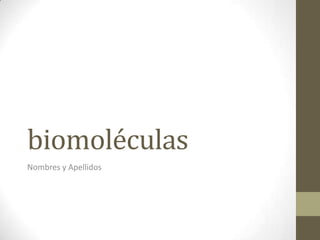
Guia 09 -_biomoleculas
- 2. menú • Generalidades, • Carbohidratos • Lípidos • Aminoácidos • Proteínas • Ácidos Nucleicos
- 3. generalidades Las biomoléculas son las moléculas constituyentes de los seres vivos. Los cuatro bioelementos más abundantes en los seres vivos son el carbono, hidrógeno, oxígeno y nitrógeno. Estos cuatro elementos son los principales componentes de las biomoléculas
- 4. carbohidratos Los glúcidos son la fuente de energía primaria que utilizan los seres vivos para realizar sus funciones vitales; la glucosa está al principio de una de las rutas metabólicas productoras de energía, la glucólisis, usada en todos los niveles evolutivos, desde las bacterias a los vertebrados
- 5. carbohidratos Índice Glucémico Glucosa 100 Características Sacarosa 65 • Fuente energética • Sus unidades estructurales son Fructosa 20 los monosacáridos • Pueden ser de origen animal o Índice vegetal 100 80 • Actualmente se clasifican 60 según el índice glucémico 40 20 0 Glucosa Sacarosa Fructosa
- 6. clasificación de carbohidratos Monosacáridos Disacáridos Polisacáridos • Tetrosas • Lactosa • Almidón • Pentosas • Galactosa • Glucógeno • Hexosas • Sacarosa • Celulosa
- 7. lípidos Los lípidos son biomoléculas muy diversas; formados por cadenas alifáticas saturadas o insaturadas, en general lineales, pero algunos tienen anillos (aromáticos). Se caracterizan por ser insolubles en agua.
- 8. clasificación de lípidos • Ácidos grasos • Cadena corta Simples • Cadena media • Cadena larga • Fosfolípidos Complejos • Glucolípidos • Lipoproteínas Sustancias • Vitaminas lipo • Ácidos biliares asociadas • Hormonas
- 9. aminoácidos Los componentes de las proteínas son alfaaminoácidos; por lo tanto, están formados por un carbono alfa unido a un grupo carboxilo, a un grupo amino, a un hidrógeno y a una cadena hidrocarbonada de estructura variable, que determina la identidad y las propiedades de los diferentes aminoácidos; existen cientos de aminoácidos diferentes, pero sólo 20 forman parte de las proteínas y tienen codones específicos en el código genético.
- 10. proteínas Las proteínas son macromoléculas formadas por cadenas lineales de aminoácidos. Por sus propiedades físico-químicas, las proteínas se pueden clasificar en proteínas simples : que por hidrólisis dan solo aminoácidos o sus derivados; proteínas conjugadas : que por hidrólisis dan aminoácidos acompañados de sustancias diversas.
- 11. clases de aminoácidos • Neutros polares: Serina (Ser, S), Treonina (Thr, T), Glutamina (Gln, Q) y Tirosina (Tyr, Y). • Neutros no polares: Glicina (Gly, G), Alanina (Ala, A), Valina (Val, V), Leucina (Leu, L), Isoleucina (Ile, I), Cisteína (Cys, C), Metionina (Met, M), Prolina (Pro, P), Fenilalanina (Phe, F) y Triptófano (Trp, W). • Con carga negativa o ácidos: Ácido aspártico (Asp, D) y Ácido glutámico (Glu, E). • Con carga positiva o básicos: Lisina (Lys, K), Arginina (Arg, R) e Histidina (His, H). • Aromáticos: Fenilalanina (Phe, F), Tirosina (Tyr, Y) y Triptófano (Trp, W) (ya incluidos en los grupos neutros)